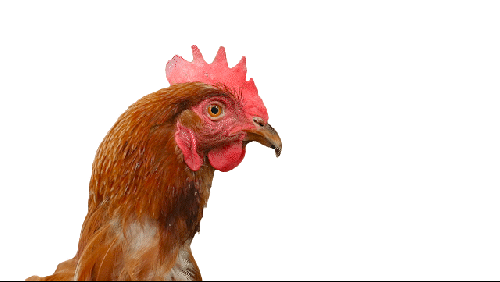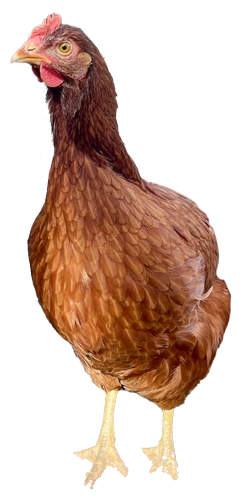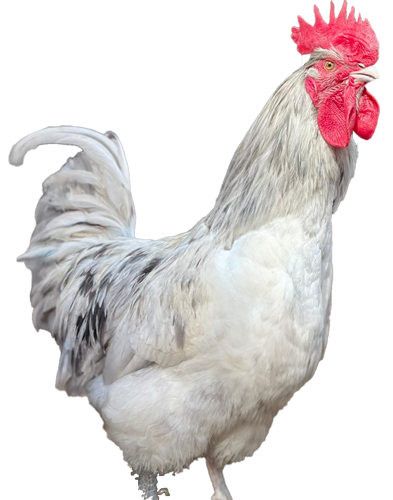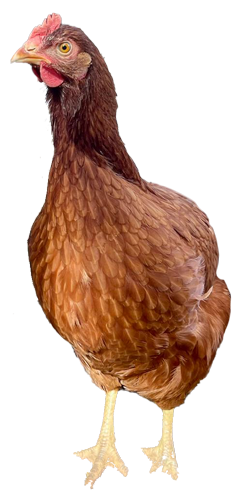
Chickens are used for all kinds of purposes: as pets, for company and fresh eggs and on farms for meat or egg production. In the last decade, there is a growing attention for the welfare of chickens in the industry and to find other ways of poultry farming that are both more efficient and pay more attention to animal welfare. Poultry veterinarian Vera Bavinck is part of this shift, and has developed ways to better monitor welfare for poultry farmers and is starter of the study group Double Purpose Chicken. At Aeres she teaches vets about chickens and international students about animal welfare.
Vera studied biology at the VU Amsterdam and Veterinary Medicine at the University Utrecht, where she specialised in farm animal health. “After my graduation, I went to Australia for five years. During these years I worked in veterinary practices that worked in both the field of pets and farm animals. When you work as a veterinarian in the outback, you treat all animals and don’t specialise. When I got back to the Netherlands, I realised I was most interested in the farm animals.”
In 2017 Vera started working at Avivet, a veterinarian practice specialised in poultry. During her time there, she came up with the idea of a welfare monitoring-instrument, which she called Kipkompas. “When Avivet was taken over by another company, I decided that I really wanted to pursue this project. So I left the practice and started my own company that focussed on the welfare of layers called Fair Poultry.”




Fair Poultry focusses on a variety of projects, of which Kipkompas, now called KipUp, is an important one. “In my years as a vet, I realised that the welfare of animals wasn’t a subject which was widely researched, measured or documented. For every vet animal welfare is important, but nobody could give figures about for example how many layers have specific injuries. Veterinary visit reports seemed limited to generalized observations regarding feather damage but did now quantify or mention other injuries. And if you don’t know how many animals have a specific problem, you can’t get to the source and you can’t solve it.”
There was already a welfare-measuring instrument called the Welfare Quality Protocol, which is a European Union subsidised project. In this, the protocols for the animal welfare of production animals are described and used to measure the welfare in every aspect. “While this works fine in a research setting, for poultry farms in practice it is a very difficult and laborious tool. It was not applicable for them. So that was my starting point for KipUp.”

Another big project of Vera’s is the double purpose chicken. This is a chicken that is bred for two purposes: for meat and for eggs. This idea started brewing in her mind during her time as a poultry vet. “I saw all these chicken with breastbone fractures, up to 90 percent of the layers had this problem. This is partly a result of the high production standard in the poultry business. The calcium in the feed goes to the eggshells and especially over time when the bird ages this calcium is also extracted from her bones. This results in very fragile bones and fractures result in suffering. These breaks were not on top of the priority list of many vets, to Vera’s amazement. She wanted to tackle this problem, so she started doing research on the broken bones. This resulted in an question: would a dual purpose chicken with a lower production be less susceptible to these fractures and at the same time provide enough growth to make the roosters a valuable chickens as well?
“I wasn’t the first one with an idea like this, I came across different groups of people who keep small scale dual purpose chickens, giving them a healthier, happier life while they still provide us with eggs and meat. So I thought, why don’t we bundle our knowledge, experience and network? That is how the study group Double Purpose Chicken was formed.” The central question for Vera and the others is if the double purpose chicken can be a worthy alternative in poultry farming. The hens lay less eggs, but are easier to keep due to their friendly nature which makes them less prone to start pecking each other. They are more robust to changes in feed for example and match extensive initiatives. In this new way of using chickens for farming, not only the layers get a better life, but also the roosters. “At this moment roosters don’t have any value for a poultry farm that focusses on eggs. We used to kill them at the hatchery. In Germany, this is prohibited but instead in ovo sexing is a growing practice. Alternatively roosters are grown till the age of 12 weeks after which they have hardly any meat on their body. The double purpose breed provide a rooster which gain weight and become valuable as meat in a natural way.”
The study group organised a variety of gatherings with each a different theme: from the genetics of a double purpose chicken to a suitable business model. After a period of researching and experimenting, the second round of hens has started laying. The chicks that are born, will be sold to small farms. For now, the double purpose chicken is not yet interesting enough for bigger scale professional farms. “We focus on the smaller poultry farms, that focus on the wellbeing of their chickens and don’t mind a lower egg production. Next to their lower production, they also eat more, which isn’t economically feasible for the large farms which produce eggs with a very narrow economic margin.” One of the small scale farms that now house double purpose chickens is a member of the study group who owned a business in mobile chicken pens, called ‘De Geluksvogel’, which translates as ‘The Lucky Chicken’. “They were searching for hens that were healthier and more able to take care of herself, ánd where the roosters grow meaty. So this project fitted them like a glove.”
The project had different test rounds, in which the group searched for a chicken breed that would fit. “In the end, we picked the Sasso Silvers, an chicken breed from France. That chicken fitted our requirements: The hens still produce 90% eggs at peak production and are friendly so don’t tend to pick each other. The roosters have enough growth to provide meat. Their meat is darker and firmer compared to broiler meat but also has more flavour.

Vera is also frequently found on the campus of Aeres Barneveld, where she teaches both Dutch veterinary professionals as well as international students at ATCI. “I teach the course ‘HELP A chicken at consultation’ for veterinarians and their staff that mostly focus on pets. Most vets don’t know much about chickens, and when someone who keeps chicken as a hobby, have a sick chicken, they tend to go to a companion animal veterinarian. Therefor I think it would be very valuable if ‘companion animal vets have the knowledge to help them, so that is why I teach this practical course at Aeres.”
At ATCI Vera teaches the international students about keeping poultry and welfare. “The way in which we think about animal welfare here and the attention it gets in for example Africa is very different. In Africa they tend to focus more on production, welfare is not their priority. So that makes it an interesting conversation between me and the students, because we both have a very different perspective. But that doesn’t mean that we can’t learn from each other and that they are not open to adjustments in welfare that are more standard in for example the Netherlands. That is why I always try to make it specific for their situation and make that the starting point for what I teach.”





Another big project of Vera’s is the double purpose chicken. This is a chicken that is bred for two purposes: for meat and for eggs. This idea started brewing in her mind during her time as a poultry vet. “I saw all these chicken with breastbone fractures, up to 90 percent of the layers had this problem. This is partly a result of the high production standard in the poultry business. The calcium in the feed goes to the eggshells and especially over time when the bird ages this calcium is also extracted from her bones. This results in very fragile bones and fractures result in suffering. These breaks were not on top of the priority list of many vets, to Vera’s amazement. She wanted to tackle this problem, so she started doing research on the broken bones. This resulted in an question: would a dual purpose chicken with a lower production be less susceptible to these fractures and at the same time provide enough growth to make the roosters a valuable chickens as well?
“I wasn’t the first one with an idea like this, I came across different groups of people who keep small scale dual purpose chickens, giving them a healthier, happier life while they still provide us with eggs and meat. So I thought, why don’t we bundle our knowledge, experience and network? That is how the study group Double Purpose Chicken was formed.” The central question for Vera and the others is if the double purpose chicken can be a worthy alternative in poultry farming. The hens lay less eggs, but are easier to keep due to their friendly nature which makes them less prone to start pecking each other. They are more robust to changes in feed for example and match extensive initiatives. In this new way of using chickens for farming, not only the layers get a better life, but also the roosters. “At this moment roosters don’t have any value for a poultry farm that focusses on eggs. We used to kill them at the hatchery. In Germany, this is prohibited but instead in ovo sexing is a growing practice. Alternatively roosters are grown till the age of 12 weeks after which they have hardly any meat on their body. The double purpose breed provide a rooster which gain weight and become valuable as meat in a natural way.”
The study group organised a variety of gatherings with each a different theme: from the genetics of a double purpose chicken to a suitable business model. After a period of researching and experimenting, the second round of hens has started laying. The chicks that are born, will be sold to small farms. For now, the double purpose chicken is not yet interesting enough for bigger scale professional farms. “We focus on the smaller poultry farms, that focus on the wellbeing of their chickens and don’t mind a lower egg production. Next to their lower production, they also eat more, which isn’t economically feasible for the large farms which produce eggs with a very narrow economic margin.” One of the small scale farms that now house double purpose chickens is a member of the study group who owned a business in mobile chicken pens, called ‘De Geluksvogel’, which translates as ‘The Lucky Chicken’. “They were searching for hens that were healthier and more able to take care of herself, ánd where the roosters grow meaty. So this project fitted them like a glove.”
The project had different test rounds, in which the group searched for a chicken breed that would fit. “In the end, we picked the Sasso Silvers, an chicken breed from France. That chicken fitted our requirements: The hens still produce 90% eggs at peak production and are friendly so don’t tend to pick each other. The roosters have enough growth to provide meat. Their meat is darker and firmer compared to broiler meat but also has more flavour.


Fair Poultry focusses on a variety of projects, of which Kipkompas, now called KipUp, is an important one. “In my years as a vet, I realised that the welfare of animals wasn’t a subject which was widely researched, measured or documented. For every vet animal welfare is important, but nobody could give figures about for example how many layers have specific injuries. Veterinary visit reports seemed limited to generalized observations regarding feather damage but did now quantify or mention other injuries. And if you don’t know how many animals have a specific problem, you can’t get to the source and you can’t solve it.”
There was already a welfare-measuring instrument called the Welfare Quality Protocol, which is a European Union subsidised project. In this, the protocols for the animal welfare of production animals are described and used to measure the welfare in every aspect. “While this works fine in a research setting, for poultry farms in practice it is a very difficult and laborious tool. It was not applicable for them. So that was my starting point for KipUp.”



Vera is also frequently found on the campus of Aeres Barneveld, where she teaches both Dutch veterinary professionals as well as international students at ATCI. “I teach the course ‘HELP A chicken at consultation’ for veterinarians and their staff that mostly focus on pets. Most vets don’t know much about chickens, and when someone who keeps chicken as a hobby, have a sick chicken, they tend to go to a companion animal veterinarian. Therefor I think it would be very valuable if ‘companion animal vets have the knowledge to help them, so that is why I teach this practical course at Aeres.”
At ATCI Vera teaches the international students about keeping poultry and welfare. “The way in which we think about animal welfare here and the attention it gets in for example Africa is very different. In Africa they tend to focus more on production, welfare is not their priority. So that makes it an interesting conversation between me and the students, because we both have a very different perspective. But that doesn’t mean that we can’t learn from each other and that they are not open to adjustments in welfare that are more standard in for example the Netherlands. That is why I always try to make it specific for their situation and make that the starting point for what I teach.”

In 2017 Vera started working at Avivet, a veterinarian practice specialised in poultry. During her time there, she came up with the idea of a welfare monitoring-instrument, which she called Kipkompas. “When Avivet was taken over by another company, I decided that I really wanted to pursue this project. So I left the practice and started my own company that focussed on the welfare of layers called Fair Poultry.”
Vera studied biology at the VU Amsterdam and Veterinary Medicine at the University Utrecht, where she specialised in farm animal health. “After my graduation, I went to Australia for five years. During these years I worked in veterinary practices that worked in both the field of pets and farm animals. When you work as a veterinarian in the outback, you treat all animals and don’t specialise. When I got back to the Netherlands, I realised I was most interested in the farm animals.”

Chickens are used for all kinds of purposes: as pets, for company and fresh eggs and on farms for meat or egg production. In the last decade, there is a growing attention for the welfare of chickens in the industry and to find other ways of poultry farming that are both more efficient and pay more attention to animal welfare. Poultry veterinarian Vera Bavinck is part of this shift, and has developed ways to better monitor welfare for poultry farmers and is starter of the study group Double Purpose Chicken. At Aeres she teaches vets about chickens and international students about animal welfare.